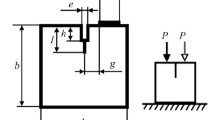Abstract
We develop a model aimed at the prediction of propagation of mode II fatigue cracks with regard for the interaction of their lips caused by the roughness of the fracture surfaces. In this model, the relationship between normal and shear contact stresses is described by the Amonton's law of friction and the plastic yield of the material in the prefracture zone is taken into account with the help of the model of thin plastic strips. The method of singular integral equations is used to solve the corresponding boundary-value problem for a plate with cracks propagating from two semiinfinite collinear notches. The distribution of contact stresses is determined and the stress intensity factors and displacements of the crack lips are evaluated. The proposed example is used to analyze the basic specific features of the influence of contact of the crack lips on fatigue fracture under the action of shear loads. The obtained results are confirmed by the experimental data on the propagation of mode II fatigue cracks in specimens of HY-130 steel.
Similar content being viewed by others
REFERENCES
D. Lal, Fatigue Crack Propagation and Fracture in Compressive Members, M. S. Thesis (Mater. Sci.), Syracuse University (1970).
H. W. Liu, “Shear fatigue crack growth: a literature survey,” Fatigue Fract. Eng. Mater. Struct., 8, No. 4, 295-313 (1985).
H. W. Liu, Ki Chen, and D. Lal, “Growth of shear fatigue cracks and their analysis,” Fiz.-Khim. Mech. Mater., 29, No. 3, 124-132 (1993).
P. E. Bold, M. W. Brown, and R. J. Allen, “A review of fatigue crack growth in steels under mixed mode I and II loading,” Fatigue Fract. Eng. Mater. Struct., 15, No. 10, 965-977 (1992).
J. Qian and A. Fatemi, “Mixed mode fatigue crack growth: a literature survey,” Eng. Fract. Mech., 55, No. 6, 969-990 (1996).
M. C. Smith and R. O. Smith, “Towards an understanding of mode II fatigue crack growth,” ASTM STP, 924, 260-280 (1988).
E. K. Tschegg, “Sliding mode closure and mode III fatigue crack growth in mild steel,” Acta Met., 31, 1323-1330 (1983).
O. N. Romaniv, S. Ya. Yarema, H. N. Nykyforchyn, et al., Fatigue and Cyclic Crack Resistance of Structural Materials [in Russian], Naukova Dumka, Kiev (1990).
S. Suresh and R. O. Ritchie, “A geometrical model for fatigue crack closure induced by fracture surface roughness,” Met. Trans., 13A, No. 9, 1627-1631 (1982).
R. Ballarini and M. E. Plesha, “The effects of crack surface friction and roughness on crack tip stress fields,” Int. J. Fract., 34, No. 3, 195-207 (1987).
T. S. Gross and D. A. Mendelsohn, “On the effect of crack face contact and friction due to fracture surface roughness in edge cracks subjected to external shear,” Eng. Fract. Mech., 31, No. 3, 405-420 (1988).
J. Tong, J. R. Yates, and M. W. Brown, “A model for sliding mode crack closure. Part I: Theory for pure mode II loading,” Eng. Fract. Mech., 52, No. 4, 599-611 (1995).
X. Yu and A. Abel, “Modelling of crack surface interface under cyclic shear loads,” Fatigue Fract. Eng. Mater. Struct., 22, No. 3, 205-214 (1999).
A. O. Andreikiv, “Generalized Griffith problem of shear with regard for the roughness of crack surfaces,” Fiz.-Khim. Mech. Mater., 36, No. 2, 49-54 (2000).
V. V. Panasyuk, Limiting Equilibrium of Brittle Bodies with Cracks [in Russian], Naukova Dumka, Kiev (1968).
W. Becker and D. Gross, “About the Dugdale crack under mixed-mode loading,” Int. J. Fract., 37, No. 3, 163-170 (1988).
V. V. Panasyuk, M. P. Savruk, and A. P. Datsishin, Distribution of Stresses near Cracks in Plates and Shells [in Russian], Naukova Dumka, Kiev (1976).
N. I. Muskhelishvili, Some Basic Problems of Mathematical Theory of Elasticity [in Russian], Nauka, Moscow (1966).
M. P. Savruk, Stress Intensity Factors in Cracked Bodies [in Russian], Naukova Dumka, Kiev (1988).
RD 50-345-82. Methodical Recommendations. Strength Analysis and Tests. Methods for Mechanical Testing of Metals. Determination of the Characteristics of Crack Resistance (Fracture Toughness) under Cyclic Loading [in Russian], Introduced on 01.01.1983, Izd. Standartov, Moscow (1983).
Author information
Authors and Affiliations
Rights and permissions
About this article
Cite this article
Darchuk, O.I. Effect of Closure of a Crack Caused by the Roughness of Its Surfaces on Fatigue Fracture under the Conditions of Transverse Shear. Materials Science 38, 315–324 (2002). https://doi.org/10.1023/A:1021712330153
Issue Date:
DOI: https://doi.org/10.1023/A:1021712330153




